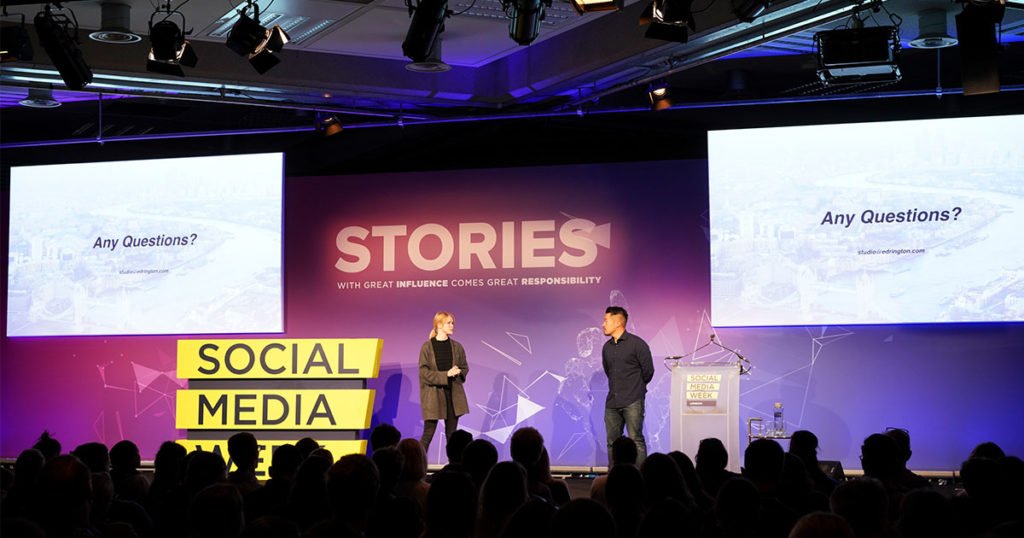It’s not often you have the face of your brand persona in the room with you, so it was a nice source of laughter to see that “Rory,” mentioned in Edrington’s session on creating content with community in mind, was not just an idea but rather a living breathing person.
Join SMW Insider to watch this #SMWLDN session
Subscribe
“Rory has many sides!” Creative Lead Anna Lisa Stone exclaimed as one photo of him turned to many on the slides. Alongside her colleague James Kim, Rory represented the opportunity we have to not just look at people through stilted personas, but rather through the company they keep and the communities they participate in. This strategy, according to Kim and Stone, allows us to move beyond who people are, and toward what makes them that way. “Community allows us to, within the larger demographic […] get him really excited and advocating for our brand.”
“Do We Have a Right to Play There?”
During Social Media Week London, Stone and Kim outlined the shift that marketing has undergone. Where we once existed in a broadcast era, we now exist in a digital era that enables “many to many” communication, versus the “one to many” model that once allowed brands to be authorities who guided action. But in a framework where many to many is prized and praised, there’s more power in speaking with one another, than at one another.
In communities, influence is built more organically, as people vouch for or sing the praises of something, and affinity grows based on trust. That’s not an easy path for brands to walk, which is why Kim included the vital question for brands who are considering reaching out to communities: “do we have a right to play there?” But when that right is earned, its efficacy can change the way brands exist in the minds of consumers.
“Modeling” the Development of a Community Audience
There’s a calculated way to align your brand with its chosen community, and it starts with a deep understanding of your brand’s DNA. When you understand your values, goals, and larger appeal, then you’re able to look for populations that align with what you have to offer. Kim offered a word of caution here: citing the quick overuse of the “bartender as influencer” model, he urged attendees to seek out prospective communities that aren’t already (pun recognized) overserved. Instead, he encouraged them to “dig deep” as they did the tight positioning work it would take to find their ideal target.
From there, effectively serving that group would allow for the brand’s appeal with interconnected communities…and from there influence spreads. By the time the brand is widely visible to the general public, a brand connection will already solidly exist. Case in point: Edrington’s Macallan is a brand that was systematically targeted at country clubs, social clubs, and other affluent members of society. By the time word trickled down to the general public, it was known for its appeal to the rich and powerful.
Varying Ages of Affluence
Of course, this isn’t a foolproof strategy. Stone did mention the possibility that a brand could become emblematic of a group in a way that a brand doesn’t expect – Patagonia and wealthy tech and finance professionals comes to mind – but more often than not, the brand does have a sense of control over who it aligns itself with. And moreover—coming back to the originally voiced challenge—there’s nuance even within these communities. Kim mentioned the difference between the more legacy-based affluence of current Macallan drinkers, and how it’s clashed with the imagery that comes with wealth earned in Silicon Valley. They look at themselves differently, and so “wealth as community” doesn’t resonate with them.
But when done well, this microtargeting around multiple, more detailed facets of personality and affinity can pay off beautifully. In honor of Halloween, Stone cited a prior Halloween campaign that had originally simply targeted Halloween fans who liked whiskey. This year, they instead targeted Scottophiles: a similar group demographically, but more deeply focused on a love and appreciation for Scottish culture. That understanding, paired with collateral that highlighted the Scottish origins of Halloween, resulted in a limited edition release that did 6x typical engagement, 10x typical organic reach, and sold out the product online in 18 minutes…all by targeting a group of people with a specific connection to their heritage. In that way, Edrington lived up to the goal that they have used to define solid community-based marketing” when they think of them, they think of you.”
Join 100,000+ fellow marketers who advance their skills and knowledge by subscribing to our weekly newsletter.

